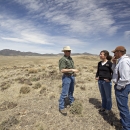A Conservation Benefit Agreement (CBA) is a voluntary agreement involving private or other non-federal property owners where the actions in the agreement contribute to the conservation or recovery of the agreement’s covered species. Covered species can include both species listed as endangered or threatened under the Endangered Species Act (ESA) and/or at-risk non-listed species. The agreement is between cooperating non-federal, property owners and the U.S. Fish and Wildlife Service (Service).
In exchange for actions that contribute to the conservation of species covered by an agreement on non-federal land, participating property owners receive formal assurances from the Service that if they fulfill the conditions of the CBA, the Service will not require any additional or different management activities by the participants without their consent.
Central to this approach is that the actions taken under the CBA will provide a net conservation benefit that contributes to the recovery or conservation of the species included in the agreement. This contribution will vary from case to case, and the CBA does not have to provide permanent conservation for the enrolled property. The benefit to the covered species depends on the nature of the activities to be undertaken, where they are undertaken, and their duration. The CBA and associated documents include a description of the expected net conservation benefit(s) and how the Service reached that conclusion. Examples of conservation benefits include:
- maintenance, restoration, or enhancement of existing habitats;
- reduced habitat fragmentation; increases in habitat connectivity;
- stabilized or increased numbers or distribution;
- the creation of buffers for protected areas; and
- opportunities to test and develop new habitat management techniques.
In addition, at the end of the agreement period, participants may choose to return the enrolled property to the baseline conditions that existed at the beginning of the CBA, if the agreement included that provision prior to permit issuance.
Who Can Participate
Any non-federal property owner can participate in the Conservation Benefit Agreement program. A property owner can enroll their entire property in the CBA or just a portion of it.
Property owners can also enroll in an existing programmatic or “umbrella” CBA that may have already been designed for prospective participants in a region or even an entire state. Such programmatic CBAs are administered by a sponsoring state or local agency or some other entity.
It is important to emphasize the CBAs are authorized only when a net conservation benefit to a covered species will result from the conservation measures taken by the property owner.
Process
Step 1 - Contact Field Office
- To participate in the CBA program, property owners that would like to conduct beneficial actions on their property for listed species, non-listed at-risk species, or their habitats, are invited to contact the appropriate Ecological Services field office.
Step 2 - Compile Property Information
- If an CBA is feasible, the property owner and the Service work together to compile information about the land, including a map, the current management, and the management needs of the covered species and/or habitat.
Step 3 - CBA Determinations
- The property owner and the Service determine the baseline condition of the property for the species -- the number and location of individuals, a habitat assessment, or a combination of the two.
- The property owner and the Service identify voluntary actions that would provide a net conservation benefit for the covered species. They also determine the duration of the CBA, allowing enough time to achieve the desired benefit.
- The property owner and Service develop a draft CBA that specifies management actions that will provide a net conservation benefit to the species. The draft agreement should describe the current and anticipated management of the property (farming, ranching, timber management, etc.). It should also address the monitoring needed to determine if the prescribed management actually benefits the covered species and/or its habitat.
- The Service identifies any anticipated incidental or purposeful take of covered species that might result from the management planned under the CBA, including any take of covered species that could be expected if the property owner elects to include the option to return the property to its baseline condition in the agreement.
Step 4 - Submit CBA and Enhancement of Survival Permit
- The property owner submits the completed CBA and an application for an “enhancement of survival permit” to the Service.
Step 5 - Announcement and Public Comment Period
- The Service then publishes an announcement in the Federal Register that it has received an application for an “enhancement of survival permit.” A 30-day public comment period follows.
- During the public comment period, the Service conducts internal reviews related to issuance of the requested permit.
Step 6 - Sign Final CBA, Permit Issuance, and Conservation Actions Begin
- Following a response to any public comments, and after incorporating any appropriate changes, the Service and the property owner approve and sign the final CBA. Assuming all permit issuance criteria have been met, the Service then issues the enhancement of survival permit for take associated with the conservation measures and ongoing land management identified in the agreement.
- The property owner begins any new conservation measures and/or continues with existing practices identified in the CBA and reports annually to the Service on the plan’s progress.

